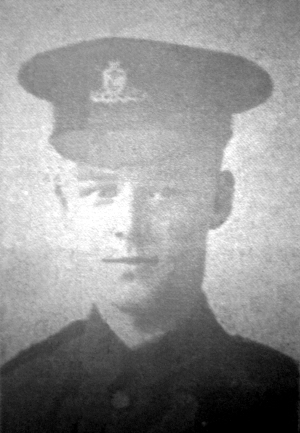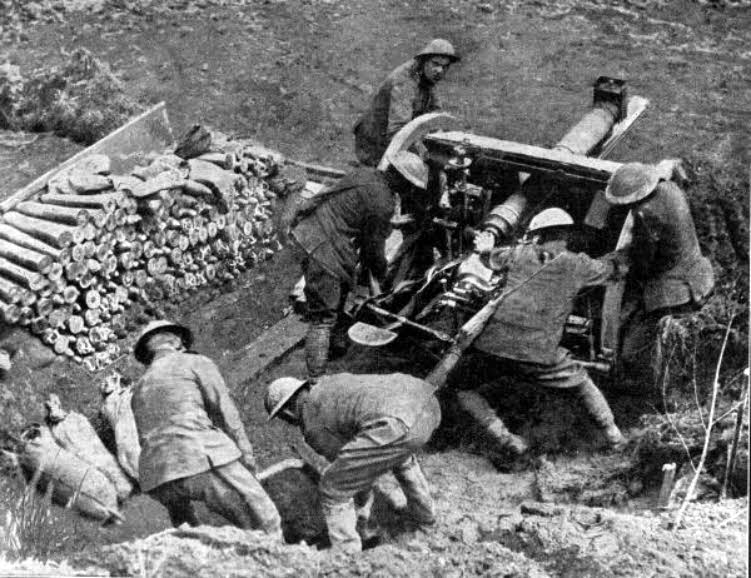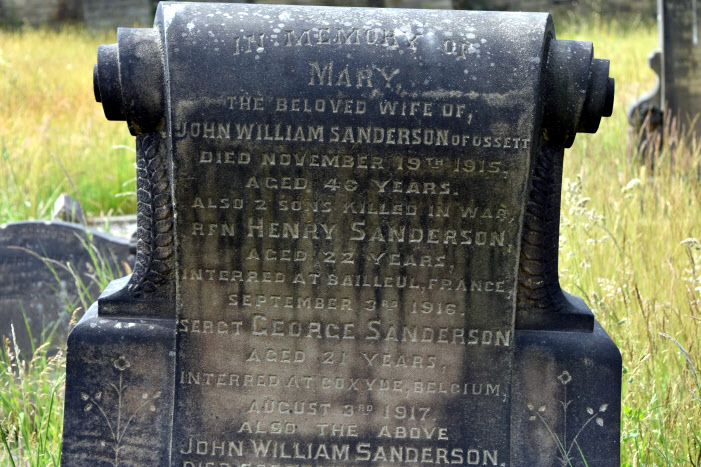
L/12050, Royal Field Artillery, ‘C’ Battery, 168th Brigade
George Sanderson was born in Ossett on the 4th October 1895 and baptised at the Free Methodist Chapel, Dale Street, Ossett on the 31st December 1899. He was the second son of John W. Sanderson and Mary (nee Wormald) who married in 1893.
In 1901 and 1911 John Sanderson, a self employed plasterer and decorator, and Mary plus their five children: four boys and a girl, born between 1894 and 1904, were living on Wesley Street, Ossett.
In 1911, only the eldest son, Henry Sanderson, was working, supporting his father in his plastering business. The other children were still at school. At the time of George Sanderson’s death, his parents lived at Brook Street, Ossett, Yorks.
George Sanderson’s elder brother Rifleman Henry Sanderson, of the 11th Battalion, Royal Irish Rifles also lost his life during WW1.
In 1915, over eight hundred men were recruited for the 168th Brigade (Huddersfield), Royal Field Artillery, most of them during May. The Brigade’s four batteries were sent to four areas: ‘A’ Battery, (Huddersfield Battery) based at Huddersfield; ‘B’ Battery, (Calder Valley Battery) based at Brighouse; ‘C’ Battery, (Holme Valley Battery) based at Holmfirth; ‘D’ Battery, (Colne Valley Battery) based at Slaithwaite. The recruiting area stretched from the borders of Halifax down into Brighouse and Huddersfield, then through Holmfirth to include Penistone; recruiting had to be stopped in Penistone to leave some room in ‘C’ Battery for some Holmfirth men.
They started out training in their own areas, and moved to Ripon for further training at brigade level in July, ‘C’ Battery left on Tuesday July 13th. Their next move was to Salisbury Plain where the weather conditions were very bad, and the ground soon turned to mud. The horses did not have sufficient rugs to protect them and they died at an alarming rate, but the health of the men remained quite good.
In December 1915, they did extremely well in competition at Larkhill and many were given leave at Christmas. On Boxing Day the men received telegrams recalling them and on December 27th 1915, they took the train to the coast and sailed for France onboard the SS ‘Inventor’, arriving at Le Havre on the same day to join the 32nd Division. After three days in billets they went into action at Meaulte, where they stayed until January 19th 1916 when they moved to Warloy. They were in action during the week before the Somme, and there were casualties in the brigade that week.1
On September 17th 1916, the 168th Brigade was re-organised. ‘C’ Battery was now made up of the old ‘B’ Battery of the 164th Brigade and half of the original ‘C’ Battery (Holme Valley Battery) of the 168th Brigade; it retained the name ‘C’ Battery, 168th Brigade and was commanded by Captain Herbert Cottee.
168th Brigade, Royal Field Artillery began with 31st Division, but moved to 32nd in New Year 1916. On the 1st August 1917, the 168th Brigade, RFA were at Nieuport on the Belgian coast. This short extract from the War Diary of the 12th Australian Field Artillery Brigade gives an indication of the conditions at the time of Sergeant Sanderson’s death:
“Nieuport, 1st August 1917 – 2/Lieut Kraefft and 12 other ranks were detailed to assist with manning guns of the 168th Brigade, R.F.A. which had taken heavy casualties.”
The “Ossett Observer” 1 had this obituary for George Sanderson:
“Ossett Tradesman’s Double Loss – Two Sons Sacrificed – Deep sympathy is felt with Mr. J. W. Sanderson, of Prospect Road, Ossett, who has this week received the sad news that his second son has been killed in the war. The eldest of four brothers, Rifleman Henry Sanderson, of the Royal Irish Rifles, died of gas poisoning in September of last year. Now the second son, Sergeant George Sanderson, of the Royal Field Artillery, has been killed.
In a letter, dated August 3rd, an officer of the battery to which Sergeant Sanderson was attached wrote: ‘It is with the deepest regret that I have to write to tell you that your son Sergeant George Sanderson died of wounds in the early hours of this morning. I cannot tell you how much he will be missed by both officers and men as he had been with the battery since it was formed and he was always so cheerful and bright. You have indeed the heartfelt and deepest sympathy of us all in the great loss you have sustained.’
Sergeant Sanderson was only 21 years of age, and had served since April 1915, when he joined the battery of artillery which was raised in Wakefield. He was then employed in the West Riding Education Department at the County Hall, Wakefield. He had been in France with his battery since the last few days in 1915 and always wrote home very cheerfully of his experiences. A field postcard was received from him only three or four days before the intimation of his death was received. He was a bright lad, well-known and popular.
Another officer Second-Lieutenant C. A. Anelay writes: ‘He was killed about 3 a.m. on the 3rd by a shell falling in his dug-out. He was brought to the wagon line and buried in a British Cemetery in a small village behind the line, by the chaplain. The name of the village I am not, of course, allowed to tell you at present. ‘His comrades are now making a cross for his grave, as a last token of their great respect. He was in my section and was a gallant soldier. The battery is poorer for his loss and all his colleagues sympathise with you sincerely.”

Above: 18lb Field Gun as used by the Royal Field Artillery during WW1
George Sanderson’s army service record has not survived, but his medal card indicates that he embarked for France on the 30th December 1915 and thus qualified for the 1914-15 Star medal in addition to the British and Victory medals.

Above: The Sanderson grave at St. John’s Methodist Chapel showing the memorial to brothers Henry and George Sanderson, sons of John William Sanderson. Picture courtesy of Lisa Jennings.
Sergeant George Sanderson died on the 3rd August 1917, aged 22 years, and is buried at grave reference II. C. 20. at the Coxyde Military Cemetery 2, Koksijde, West-Vlaanderen, Belgium. Coxyde Military Cemetery is located approximately 500 metres beyond the village of Koksijde on the N396 towards De Panne.
In June 1917, Commonwealth forces relieved French forces on 6 kilometres of front line from the sea to a point south of Nieuport (now Nieuwpoort), and held this sector for six months.
Coxyde (now Koksijde) was about 10 kilometres behind the front line. The village was used for rest billets and was occasionally shelled, but the cemetery, which had been started by French troops, was found to be reasonably safe. It became the most important of the Commonwealth cemeteries on the Belgian coast and was used at night for the burial of the dead brought back from the front line.
The French returned to the sector in December 1917 and continued to use the cemetery, and during 1918, Commonwealth naval casualties from bases in Dunkirk (now Dunkerque) were buried there. After the Armistice, the remains of 44 British soldiers were brought into the cemetery. Ten of them had been buried in isolated graves. Nineteen came from Furnes Road British Cemetery, Coxyde, a cemetery made in July, 1917, by the 2nd Manchesters and the 49th (West Riding) Division on the East side of the road to Furnes (now Veurne). Twenty-five (of whom 22 belonged to the 49th Division) came from Oosthoek Military Cemetery, Adinkerke, 4 Kms South-West of Coxyde.
The cemetery now contains 1,507 Commonwealth burials of the First World War, the French graves from this period having since been removed. Of the 155 Second World War burials, 22 are unidentified.
References:
1. Information from Tony Lund, “Great War Forum”, posted 1st May 2008
1. “Ossett Observer”, 17th August 1917